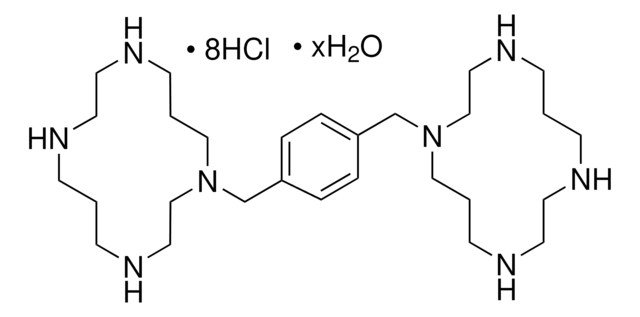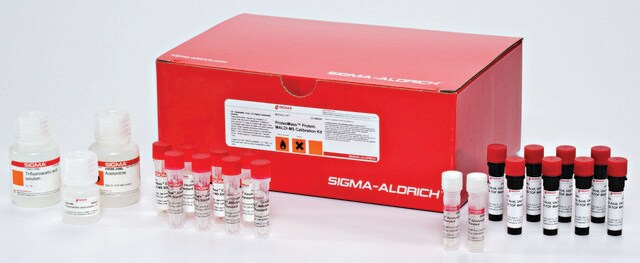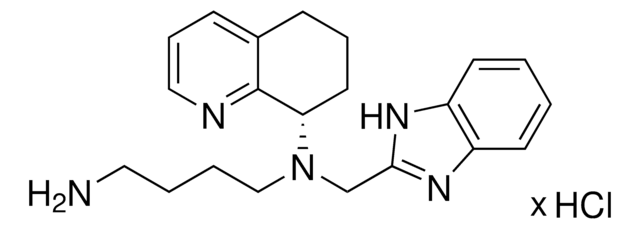239820
AMD3100 octahydrochloride hydrate
≥98% (HPLC), solid, CXCR4 antagonist, Calbiochem
Sinonimo/i:
CXCR4 Antagonist I, AMD3100, 1,1ʹ-(1,4-Phenylene bis(methylene))- bis-1,4,8,11-tetraazacyclotetradecane, 8HCl, JM3100, 1,1ʹ-(1,4-Phenylenebis(methylene))-bis-1,4,8,11-tetraazacyclotetradecane, 8HCl, JM3100
About This Item
Prodotti consigliati
product name
CXCR4 Antagonist I, AMD3100, The CXCR4 Antagonist I, AMD3100, also referenced under CAS 155148-31-5, controls the biological activity of CXCR4. This small molecule/inhibitor is primarily used for Cell Signaling applications.
Livello qualitativo
Saggio
≥98% (HPLC)
Forma fisica
solid
Produttore/marchio commerciale
Calbiochem®
Condizioni di stoccaggio
OK to freeze
desiccated (hygroscopic)
protect from light
Colore
off-white
Solubilità
water: 10 mg/mL
Condizioni di spedizione
ambient
Temperatura di conservazione
2-8°C
InChI
1S/C28H54N8.8ClH/c1-9-29-15-17-31-13-3-21-35(23-19-33-11-1)25-27-5-7-28(8-6-27)26-36-22-4-14-32-18-16-30-10-2-12-34-20-24-36;;;;;;;;/h5-8,29-34H,1-4,9-26H2;8*1H
UEUPDYPUTTUXLJ-UHFFFAOYSA-N
Descrizione generale
Confezionamento
Attenzione
Ricostituzione
Altre note
Pitchford, S.C., et al. 2009. Cell Stem Cell4, 62.
De Clercq, E. 2009. Biochem. Pharmacol. , 1655.
Thoma, G., et al. 2008. J. Med. Chem.51, 7915.
De Clercq, E. 2000. Mol. Pharmacol.57, 833.
Note legali
Codice della classe di stoccaggio
11 - Combustible Solids
Classe di pericolosità dell'acqua (WGK)
WGK 3
Punto d’infiammabilità (°F)
Not applicable
Punto d’infiammabilità (°C)
Not applicable
Certificati d'analisi (COA)
Cerca il Certificati d'analisi (COA) digitando il numero di lotto/batch corrispondente. I numeri di lotto o di batch sono stampati sull'etichetta dei prodotti dopo la parola ‘Lotto’ o ‘Batch’.
Possiedi già questo prodotto?
I documenti relativi ai prodotti acquistati recentemente sono disponibili nell’Archivio dei documenti.
Il team dei nostri ricercatori vanta grande esperienza in tutte le aree della ricerca quali Life Science, scienza dei materiali, sintesi chimica, cromatografia, discipline analitiche, ecc..
Contatta l'Assistenza Tecnica.







